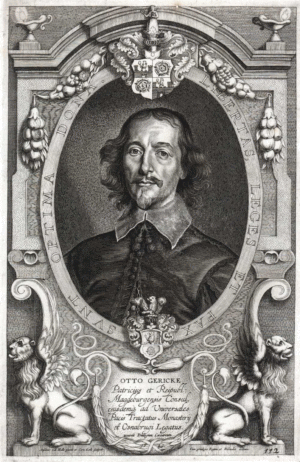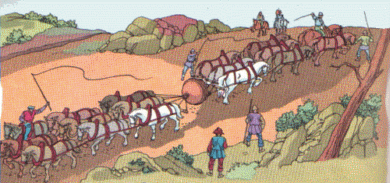 SKC Films Library |
| SKC Films Library >> Science >> Physics >> Biography |
| Otto von Guericke [gA' ri kE] the man who proved that vacuums exist
Otto Gericke was born on November 20, 1602, at Magdeburg, Prussian Saxony (now in Germany). He was educated at the University of Leipzig and studied law at the University of Jena and mathematics and mechanics at the University of Leyden. In 1631 he became an engineer in the army of Gustavus II Adolphus of Sweden, and from 1646 to 1678 he was bürgermeister (mayor) of Magdeburg and magistrate for Brandenburg. In 1650 Gericke invented the air pump, which he used to create a partial vacuum. Subsequent experiments proved that light travels through a vacuum but sound does not. In 1654, in a famous series of experiments performed before Emperor Ferdinand III at Regensburg, Gericke demonstrated the capacity of the atmosphere to do work and decisively refuted the long-held notion that it was impossible for a vacuum to exist. His most famous experiment is depicted in the picture below. The big ball is a hollow copper ball made in two halves that are not fastened together. After using his air pump to remove most of the air from the sphere (creating a vacuum inside the sphere), Gericke tied a team of strong horses to each hemisphere. Even though the sphere was held together only by the air around it, the horses were unable to pull the hemispheres apart. In 1663 Gericke invented the first electric generator, which was made of a large sulfur ball cast inside a glass globe, mounted on a shaft. The ball was rotated by means of a crank, and a static electric spark was produced when a pad was rubbed against the ball as it rotated. The globe could then be removed and used as a source for experiments with electricity. In 1672 he discovered that the electricity thus produced could cause the surface of the sulphur ball to glow, becoming the first man to view electroluminescence. Gericke did not, however, recognize the effect he generated as static electricity.
On January 4, 1666, Otto Gericke was raised to the peerage by Emperor Leopold I, thus becoming Otto von Guericke. Guericke also studied winds and weather and built a water barometer. His water barometer had a glass tube more than 30 feet tall that reached up through the roof of his house. The tube was almost completely filled with water, and a little wooden figure floated on the water. On clear days the water rose, and the little figure appeared above the roof. On cloudy days the water went down and the little figure disappeared below the roof. Guericke's only major published work, Experimenta nova Magdeburgia de vacuo spatio (New Magdeburg Experiments About the Vacuum), was completed in 1663 and published in Amsterdam in 1671. Otto Von Guericke died in Hamburg on May 11, 1686. |
| SKC Films Library
>> Science >> Physics >> Biography This page was last updated on 10/24/2017. |


